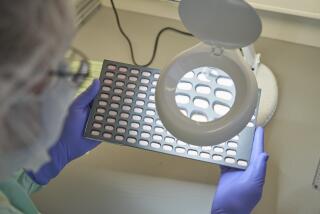Children to Get AIDS Drug AZT Under New Rule
WASHINGTON — Health and Human Services Secretary Louis W. Sullivan is expected to announce today that the Food and Drug Administration will make the antiviral drug AZT available to children under 13 who are suffering from AIDS or advanced infection with the AIDS virus.
The government has been under increasing pressure to make AIDS treatments more available to children. Until now, youngsters have not had access to AIDS medications because it has been long-standing FDA policy that no drug can be tested on or made available to children until it has been tested on and approved for adults.
“We hope that this will set the stage for the rapid approval of other new drugs for children, and that they will not have the 2 1/2 or three-year time lag between approval for adults and approval for children,” said Susan DeLaurentis, co-founder of the Los Angeles-based Pediatric AIDS Foundation, which raises money for pediatric AIDS research.
AZT, approved for adults in 1987, has been tested on more than 200 children, and some clinical trials are still under way. Once a drug has been approved for sale, physicians often prescribe it as they see fit, even for unapproved uses. But many doctors have been reluctant to give AZT to children, fearing that its side effects might be too severe for young patients.
AZT can cause toxic reactions, including severe anemia that must be treated with blood transfusions.
The pediatric trials of AZT have shown that its side effects in children are similar to those in adults, according to a Department of Health and Human Services source who requested anonymity.
The studies also indicated that AZT produces the same benefits in children as in adults: It prolongs survival, relieves symptoms and enhances the quality of the patient’s life, the source said.
The drug will be made available to children as a Treatment IND, or investigational new drug, a designation that permits widespread use of a drug for compassionate reasons while research continues.
Burroughs Wellcome Co., the drug’s manufacturer, said it will make the drug available at no cost under the Treatment IND classification.
Many of the children afflicted with AIDS, however, are inner-city minorities whose parents may not have insurance or qualify for Medicaid. Such families may not be able to afford the high cost of the drug once it receives FDA approval. AZT therapy costs about $6,500 a year since a recent 20% price cut.
“Science cannot resolve these social and political problems,” said Mathilde Krimm, founding co-chairman of the American Foundation for AIDS Research. “The best drugs in the world will be worthless unless people can get to them. One can doubt, at the present cost of the drug, that it will reach them.”
So far, 1,859 cases of AIDS in children have been reported since the disease was identified in 1981, and about 800 children currently are living with the disease. No reliable estimate of the number of children infected with the human immunodeficiency virus is available; it has been estimated that perhaps 1.5 million Americans of all ages may be infected.
“There has been an ongoing desire on the part of the FDA and the company to find a way to make this drug available to kids, realizing that the safety question is perhaps a more difficult question to address,” another Health Department source said. “Also, perhaps the dosage size will have to be scaled down for kids.”
The company recently announced that it soon will make AZT available in a strawberry-flavored liquid form that “will make it much easier to give to kids,” the source said.
Pediatric AIDS groups and others applauded the idea.
“There are so many children who, up to this point, have been unable to access any kind of treatment, so this will be a good thing for those children,” said Susan Campbell, assistant director of the Washington office of the American Academy of Pediatrics and chairman of the Pediatric AIDS Coalition, a group of 25 national pediatric AIDS organizations.
“It is also a mark of recognition of the exploding problem among infants, children and adolescents,” she said.
Peters Wilson, director of government relations for the National Assn. of Children’s Hospitals, said that “many children’s hospitals have been . . . extremely concerned about their ability to provide the full and most appropriate treatment for children--and will welcome the opportunity now to be able to do so.”
Rep. Henry A. Waxman (D-Los Angeles), chairman of the House Energy and Commerce subcommittee on health and the environment, said that “pediatric AIDS drugs are long overdue.”
“It may never be a big market, but we have a moral obligation to find out their safety and effectiveness,” Waxman said. “I hope that these delays won’t be repeated in the future.”
More to Read
Sign up for Essential California
The most important California stories and recommendations in your inbox every morning.
You may occasionally receive promotional content from the Los Angeles Times.










